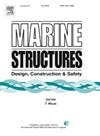通过船体监测数据验证二维光谱 AIS 方法的准确性
IF 5.1
2区 工程技术
Q1 ENGINEERING, CIVIL
引用次数: 0
摘要
讨论了利用一艘大型矿石运输船的船体监测数据对二维波谱 AIS 方法(使用二维波谱的 AIS 方法;2D-AIS 方法)进行精度验证的问题。AIS 方法利用基于 AIS 的船位数据、后报波浪数据和响应特性数据预测实际船舶的响应。传统的 AIS 方法使用波谱建模中的代表性参数(H、T、θ)。建模涉及许多不确定因素。通过使用二维波谱,研究了与波谱建模相关的不确定性的影响。与本研究进行的监测数据分析相比,发现二维 AIS 方法将精度提高了约 15%,而传统 AIS 方法与实际测量值相比,在长期最大预期值方面的误差高达约 35%。这种提高归因于建模波谱无法准确表示在极端海况下观测到的双峰值波谱,导致无法再现与响应峰值频率相对应的波频成分。这些发现强调了二维-AIS 方法在完善长期船体应力估计方面的有效性,从而为提高船体结构的安全性和性能提供了宝贵的见解。本文章由计算机程序翻译,如有差异,请以英文原文为准。
Accuracy verification of the 2D spectral AIS method by the hull monitoring data
Accuracy validation of the 2D spectral AIS method (AIS method using two-dimensional wave spectrum; 2D-AIS method) using hull monitoring data of a large ore carrier is discussed. The AIS method predicts the response of actual ships using AIS-based ship position data, hindcast wave data, and response characteristics data. The conventional AIS method uses representative parameters(, , ) from wave spectrum modeling. The modeling involves many uncertainties. By using the 2D wave spectrum as it is, the effect of uncertainties associated with wave spectrum modeling is investigated. Compared to the analysis of the monitoring data conducted in this study, it was found that the 2D-AIS method improves the accuracy to about 15 %, while the conventional AIS method shows an error of up to about 35 % compared to the actual measurements in the long-term maximum expected values. This enhancement is attributed to the inability of the modeled wave spectrum to accurately represent the two-peak wave spectrum observed in extreme sea states, leading to a deficiency in reproducing wave frequency components corresponding to peak frequencies of the response. The findings underscore the effectiveness of the 2D-AIS method in refining long-term hull stress estimations, thus offering valuable insights for enhancing the safety and performance of hull structures.
求助全文
通过发布文献求助,成功后即可免费获取论文全文。
去求助
来源期刊

Marine Structures
工程技术-工程:海洋
CiteScore
8.70
自引率
7.70%
发文量
157
审稿时长
6.4 months
期刊介绍:
This journal aims to provide a medium for presentation and discussion of the latest developments in research, design, fabrication and in-service experience relating to marine structures, i.e., all structures of steel, concrete, light alloy or composite construction having an interface with the sea, including ships, fixed and mobile offshore platforms, submarine and submersibles, pipelines, subsea systems for shallow and deep ocean operations and coastal structures such as piers.
 求助内容:
求助内容: 应助结果提醒方式:
应助结果提醒方式:


